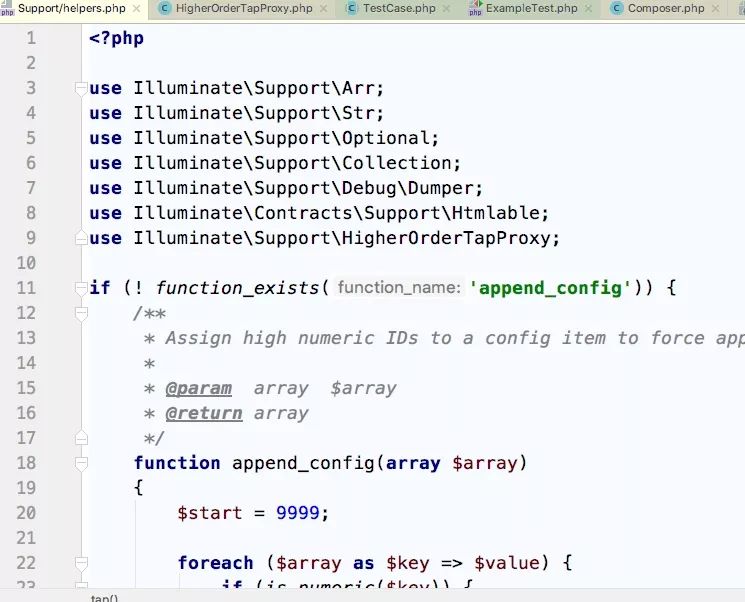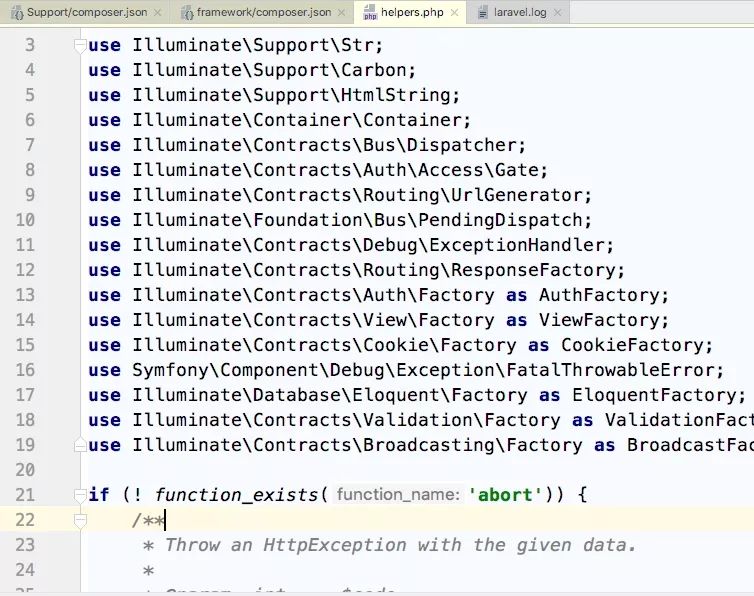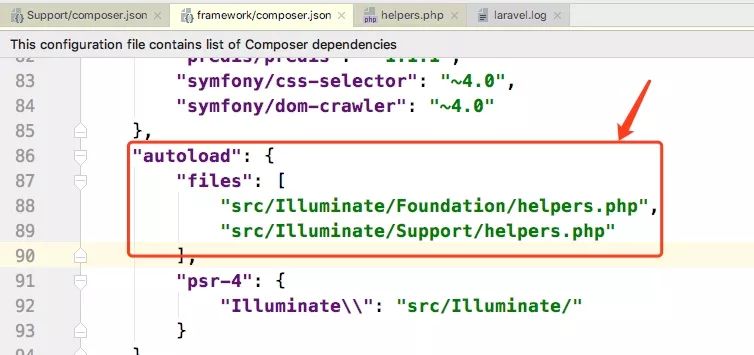轻轻玩转 Laravel Helpers 函数
Posted coding01
tags:
篇首语:本文由小常识网(cha138.com)小编为大家整理,主要介绍了轻轻玩转 Laravel Helpers 函数相关的知识,希望对你有一定的参考价值。
在使用 Laravel 函数时,我们都避免不了使用其提供的各种各样的全局函数,也称为辅助函数。
主要集中为处理数组、文件路径、路由和字符串等。
今天主要说说我喜欢的几个常用 Helper 函数,以及 Helpers 实现原理,最后依葫芦画瓢,自定义我们自己的全局函数。
4 个好玩的 Helpers 函数
data_get()
The data_get function retrieves a value from a nested array or object using “dot” notation:
The data_get function also accepts a default value, which will be returned if the specified key is not found
data_get() 函数利用“.”符号,从嵌套数组或者对象中检索数值,其中第三个参数是设置默认值,当检索健不存在时。
$array = ['albums' => ['rock' => ['count' => 75]]];
$count = data_get($array, 'albums.rock.count');
// 75
$avgCost = data_get($array, 'albums.rock.avg_cost', 0);
// 0
$object->albums->rock->count = 75;
$count = data_get($object, 'albums.rock.count');
// 75
$avgCost = data_get($object, 'albums.rock.avg_cost', 0);
// 0在多级嵌套中,并不是每级 key 值都一致,对于同级不同 key 值,可以使用通配符 (*) 代替,如:
$array = ['albums' => ['rock' => ['count' => 75],
'punk' => ['count' => 12]]];
$counts = data_get($array, 'albums.*.count');
// [75, 12]
$array = ['albums' => ['rock', 'punk' => ['count' => 12]]];
$counts = data_get($array, 'albums.*.count');
// [NULL, 12]str_plural()
对于我这英语不好的人来说,如何将单数形式写成复数形式,有时候就会闹出笑话了,但使用 str_plural() 方法,那就便捷多了,其中第二个参数是数值,如果大于 1 时,则转为复数形式,否则还是单数形式。
str_plural('dog');
// dogs
str_plural('cat');
// cats
str_plural('dog', 2);
// dogs
str_plural('cat', 1);
// cat
str_plural('child');
// children
str_plural('person');
// people
str_plural('fish');
// fish
str_plural('deer', 2);
// deer
str_singular('children')
// child同时也有复数转单数函数:str_singular()
value() and with()
value() 函数根据传入的值,返回数据,如果,传入的是闭包函数,则会直接运行闭包函数,返回结果:
$result = value(5);
// 5
$result = value(function () {
return false;
});
// falsevalue() 个人觉得,更多用在于高阶函数中,闭包函数作为高阶函数的传值传入;
和 value() 相比,可以利用 with() 函数传入参数值:
$callback = function ($value) {
return (is_numeric($value)) ? $value * 2 : 0;
};
$result = with(5, $callback);
// 10
$result = with(null, $callback);
// 0
$result = with(5, null);
// 5tap()
<?php
function tap($value, $callback){
$callback($value);
return $value;
}传入 value 值,并对 value 值进行操作,最后再返回 value。tap 函数就好将 value 值进行镀金,修改 value 对象的状态和属性,最后返回结果可以进行后续操作。如:
<?php
return tap($user)->update([
'name' => $name,
'age' => $age,
]);当我们传入一个 $user model 到 tap 方法后,我们就可以链式各种 Model 函数,正常情况下,update 方法返回的是 boolean 类型,正因为我们用了 tap 函数,update 方法返回的是 user model 对象,可以继续链式 Model 方法,操作 user 模型对象。
其它
更多全局 Helpers 函数,参见:
https://laravel.com/docs/5.6/helpers
Helpers 函数实现原理
当我们在使用这些函数时,印入脑子里的第一个问题就是:Laravel 是怎么实现的?
所以我们需要从 Laravel 框架源代码入手。
在 PhpStorm IDE 转到这些全局函数定义时,发现主要集中在这两个文件中:
"src/Illuminate/Foundation/helpers.php",
"src/Illuminate/Support/helpers.php"

因为这些函数并不是定义在对象中,而要达到全局加载的目标,Laravel 通过 Composer autoload 加载的方式载入:

引自:https://docs.phpcomposer.com/04-schema.html
Files
如果你想要明确的指定,在每次请求时都要载入某些文件,那么你可以使用 ‘files’ autoloading。通常作为函数库的载入方式(而非类库)。
实例
{
"autoload": {
"files": ["src/MyLibrary/functions.php"]
}
}接下来我们看看其中一个函数是怎么写的:
if (! function_exists('tap')) {
/** * Call the given Closure with the given value then return the value. * * @param mixed $value * @param callable|null $callback * @return mixed */ function tap($value, $callback = null) {
if (is_null($callback)) {
return new HigherOrderTapProxy($value); }
$callback($value);
return $value; } }可以看出,每个函数都是以这种格式的:
if (! function_exists('xxx')) {
function xxx() {
// ...
}
}注:从 tap 函数源代码可以看出,无论传入的 $callback 闭包函数有没有返回值,函数返回的值,都是 $value,和传入的值一样,这样也就达到「」的目标。
自定义 Helpers 函数
如果以上 Helpers 函数还满足不了你的话,我们就可以通过上文的方式来自定义 Helpers 函数,来满足我们自己的开发需求。
主要有以下几步:
在项目中创建 helper.php 文件
在 composer.json 中将 helper 文件 autoload 载入
composer dump-autoload
在 helper.php 文件写入我们的全局函数
test
举个栗子
以上是关于轻轻玩转 Laravel Helpers 函数的主要内容,如果未能解决你的问题,请参考以下文章